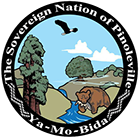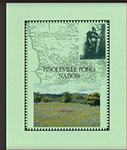Self-Governance
 No right is more sacred to a nation, to a people, than the right to freely determine its social, economic, political, and cultural future without external interference. The fullest expression of this right occurs when a nation freely governs itself. We call the exercise of this right Self- Determination. The practice of this right is Self- Governance.
No right is more sacred to a nation, to a people, than the right to freely determine its social, economic, political, and cultural future without external interference. The fullest expression of this right occurs when a nation freely governs itself. We call the exercise of this right Self- Determination. The practice of this right is Self- Governance.
- Joe De La Cruz
Brief Time Line & History
After many centuries of federal policies, Tribal self-determination has been the official mark of the United States Indian policy. Self-determination is also a human right. Nothing is new about self-determination and self-governance, for native tribes have governed themselves for thousands of years before the European discovery of the New World. The elements underlying the laws of self-governance programs come from inherent tribal sovereignty and the history between the interactions of both tribal and Euro-American governments. The Indian Self- Determination and Education Assistance Act of 1975 (ISDEAA) has provided the legal framework within which tribes can exercise their right to self-determination and self-governance, developing the capacity for government-building activities. For the last forty years the self-determination policy manifested in the ISDEAA has been very successful in assisting tribes to develop their local economies and build their governmental capacities. A brief look at the history between the interactions of tribal and American governments may help clarify the basis of the current self-governance law and policies of today and where they may lead in the future.
Relations Between Colonists & Natives (1776-1826)
Many tribes at the colonial era already possessed cultivated forms of governments as well as an expansive system of trade among themselves and early colonists. Relations between the colonist and natives where based on the understanding that the natives did preferred to remain a distinctive people, governing themselves on their own lands and on their own terms. Recognizing this preference by the United States, began the settings to early federal Indian policy.
After the American Revolutionary War in 1776 and the formation of the United States Constitution in 1789, the relationship between the newly formed country and the natives was ambivalent. Treaties was made between the states and the natives, by this, giving formal recognition of government to government relations between them both. But on the other hand, the natives which were referred to as savages and seen as an inferior race compared to the white “civilization.” The natives was considered doomed and in line for extinction. President George Washington in 1783, put it “the gradual extension of our settlements will certainly cause the Savage as the Wolf to retire; both being beasts of prey tho’ they differ in shape.” Sometime later a less threating image figured the natives as children of the Great White Father in Washington.
Tribes coexisted un-easily with this paternal and outright hostility during the time of the formation of the United States, tribes were comparable to states of the union and foreign nations as the Constitution indicated in granting Congress the exclusive power to regulate Commerce with not only foreign nations but with also with the states and Indian Tribes. This so called “Indian Commence Clause” became and will remain as the primary basis of federal authority over tribes, to mean that Congress has “plenary power” over tribes. Recognizing, that the federal government had moral as well as legal responsibility toward tribes and their members, the Northwest Ordinance of 1789 was made. Northwest Ordinance basically stated good faith shall always be observed towards natives, their land and property shall never be taken without their consent. The pronouncements did serve to establish the federal government as the nominal protector of natives rights. With plenary power came equivalent moral obligations, (at least in theory). Chief Justice John Marshall authored three land mark United States Supreme Court opinions in the 1820’s and 1830’s that established foundational principles of federal Indian law.
Marshall’s Indian Law Trilogy & Indian Removal Policy (1826-1887)
Chief Justice Marshall Law trilogy, sought to complement competing legal, cultural, and political traditions as the States did recognize native tribes as governments that exercise independence over their respective territories and their people. At the same time the philosophical justification for dispossessing natives from their land required that the tribes were not looked as equals but as savages destined to be extinct by America’s Manifest Destiny. Marshall’s opinions managed to preserve important tribal rights, including tribal sovereignty and the right to self-governance despite the already expropriation of Indian lands.
In the case of Johnson v. M’Intosh, the case were two claimants had bought a title to a parcel of land, M’Intosh, who bought it from the federal government and Johnson, who bought it from the Piankeshaw Nations. The Supreme Court affirmed the doctrine of discovery, any nation discovers territory gains the exclusive right to extinguish the Indian title of occupancy by either by purchase or conquest. Since the rights of the land was given to the United States by Great Britain after the Revolutionary war, Great Britain relinquished it’s discovery rights to the United States, giving the United States clear title….subject only to the Indian right of occupancy, thus the tribal land grant was invalid and only the United States can extinguish Indian title and convey title to an individual. The United States extinguished the Indian title by purchasing the land from the nation and in turn selling it to M’Intosh. History over rides natural law and to rule for the Indian grantee would have to undermine title to the entire country. Although the federal government held the ultimate title, tribes retained the right of possession and use, this Indian title derives from the natural sovereignty of tribes and can only be extinguished by the federal government. This case legitimized the historical process of conquest and colonization but also enshrined important Indian property rights and principles of tribal self-governance.
In the second case, laid the base of the trust relationship between the tribes and government. In Cherokee Nation v. Georgia, the Cherokee Nation sought to order Georgia from enforcing state laws on tribal lands: the laws was clearly design to challenge tribal government and take hold of tribal lands. Marshall believed that the courts lacked jurisdiction and the Constitution allows courts to hear controversies between a state and a foreign state. But was the Cherokee Nation a foreign state? Marshall concluded that tribes including the Cherokee Nation, because of the numerous treaties entered into by the tribal and federal governments, tribes were clearly seen as distinct political entities. He also concluded, like their land base, their sovereignty was limited by treaty cessions and by the historical process of incorporation by the United States. Marshall believed and wrote that the tribes were not foreign nations but “domestic dependent nations.” Tribes were “in a state of pupillage” to their civilized tutors. “Their relation to the United States resembled that of a ward to his guardian.” So Marshall’s conclusion was that the Constitution grants federal courts jurisdiction over disputes involving states and foreign states, therefore the Cherokee Nation being a “domestic” nation, their remedy was not in federal courts. Marshall’s comparison to tribes as wards to their guardians and pupils to their civilized tutors, may be very demeaning in today’s standards but they voiced a moral and legal responsibility on the part of the federal government that would evolve into the enforceable obligations of a trustee. Since Marshall, much of federal Indian law has involved the nature and outlines of this trust relationship.
Worcester v. Georgia, this case involved the relationship between tribes and states. In this case several missionaries to the Cherokees were convicted of violating a Georgia law prohibiting non-Indians from residing in Cherokee territory without a license from the governor. Marshall affirmed that tribes are “distinct, independent political communities,” as recognized by the United States. “The Cherokee Nation, as a distinct community occupying its own territory, with boundaries accurately described, in which the laws of Georgia can have no force.” The Supreme Court overturned the convictions on the ground that Georgia’s laws did not apply in Cherokee territories even within the exterior boundaries of the state of Georgia. Federal authority harmoniously limited authority to states over tribes founding the general rule that states lack jurisdiction in Indian territories located within state boundaries.
As Marshall was voicing the responsibilities of the United States to its domestic and dependent Indian nations, it had become clear that the native nations were not retiring into the wilderness with the wolves as George Washington had predicted. The federal government pursued a policy of removing eastern tribes to territories in the west to free up tribal lands for white settlement. This removal policy was applied with the election of Andrew Jackson in 1828 and in 1830 Congress passed the Indian Removal Act. Because articulated in the policy of the Northwest Ordinance, removal was to be on a voluntary decision but Jackson stated that any tribes refusing to be relocated would lose federal protection and be subjected to state laws and jurisdiction. Tribes who did not comply with this policy were removed forcefully. The Cherokee Trails of Tears forced tribes to march to the new Indian Territory in Oklahoma, with consequential loss of life and cultural upheaval. By 1850, most tribes had been removed from the East, although some groups had escaped removal they ultimately gained federal recognition and protection. The Cherokee cases was the last attempts to resist removal, as they prevailed in Worcester, their cause was doomed politically but the Marshall trilogy established several lasting principles of federal Indian law: the inherent sovereignty of tribes; their status as separate governments; the federal government’s exclusive authority over and consequent responsibility for the dependent tribes and the lack of state power over Indians affairs.
Allotment, Assimilation, & Termination (1887-1970)
With rapid expansion toward the west, Jackson’s removal of the natives was not the solution so a reversal of policies from removal to assimilation was placed. Beginning with Congress stating an end of formal government to government relations by banning new treaties in 1871. Second through the General Allotment Act (also known as the Dawes Act), an instituted program by Congress enforcing assimilation, by breaking up tribally owned reservation lands and allotting them to individual Indian owners. This attempt to “ the civilization of Indians” would break up the old communal life making them individual farmers, other lands and allotted tribal lands was sold off to non- Indians and corporations. The Indian land base dwindle from 138 million acres in 1887 to 48 million in 1934. Results of this settlement can be seen in the jurisdictional boxes, parcelization and multiple ownership of many reservations.
A rise in federal domination and an equivalent decline in tribal governments, was seen in the Allotment era. The Bureau of Indian Affairs (BIA) created in 1824, bloomed as a federal, bureaucratic alternative to self-governance by Congress. Solidifying and greatly impacting the BIA presence by passing the Snyder Act in 1921. This policy expanded the BIA authority to expend funds for reservation activities such as healthcare, education and employment. The BIA assumed the role of administrators on the reservations administrating programs and services, this policy later became known as ‘paternalism.’ Congress then passed the Indian Reorganization Act (IRA or Wheeler-Howard Act) which target to reverse the erosion of the tribal land base by eliminating allotment and authorizing the Secretary to take Indian land into trust. The IRA’s goal was to revive tribal self-governance by providing for formal adoption of tribal constitutions, tribal corporations and formal tribal membership enrollment procedures.
Two decades later, Congress once again altered course again by beginning the Termination Era, which the United States formally rejected government to government relations with over one hundred federally recognized Indian tribes, thus ending their federally recognition as tribes. The goal was to end federal supervision and control over Indian “wards,” weaken tribal governments, and assimilate individual Indians through relocation from reservations to big cities.
Self-Determination (1970-Present Day)
By the 1960’s, the termination policy was slowly giving away once again to tribal rights to self-determination. The Kennedy Administration never looked toward the termination of any tribes and through the programs of the Great Society by the Johnson Administration, embracing Indian tribes through unprecedented investments in Indian social programs and reservation infrastructure. In 1968, Congress passed the Indian Civil Rights Act, making guarantees of the Bill of Rights applicable to Indian Tribes. Also expressing favoring tribal rights to self-determination. In 1968, President Johnson delivered a special message to Congress about natives, called “The Forgotten American” first message devoted solely to Native Americans and federal Indian policy. The concept of self-determination envisioned by President Johnson, included legal and political sovereignty, fulfillment of treaty obligations, return and protection of homelands, and the furtherance maintenance of the United States trust responsibilities.
In 1970, President Nixon recognizing that the Termination Era was a disaster for all tribal governments throughout Indian country not only embraced this vision but ushered in a new era calling for the abolition of termination and its destructive effects on tribal communities and calling for self-determination for all Indian tribes. President Nixon determined to define self-determination and make it the official federal Indian policy, proposed a legislative package designed to expedite transfer of the administration of federal programs to Indian tribal governments. Took Congress nearly five years to respond, but it finally passed the Indian Self-Determination and Education Assistance Act of 1975 which replicates congressional acceptance of tribal autonomy and the failure of termination policies.
Indian Self-Determination & Education Assistance Act
The ISDEAA is largely concerned with strengthening of tribal governments and tribal organizations on Indian reservations by emphasizing tribal administration of federal Indian programs, services, functions, and activities as well as associated funds The Act consists of five major sections: (1) a self-determination contracting program within the BIA and the Indian Health Service (HIS). (2) Education assistance programs under Title II; (3) a permanent self-governance program within the DOI for both BIA and non-BIA programs; (4) a permanent self-governance program within the DHHS and (5) a feasibility study for including non-HIS agencies within the DHHS in a self-governance demonstration project under Title VI. Much more information about the structure of the ISDEAA can be acquired by referencing to “American Indian Law Review Established 1973 by The University of Oklahoma College Of Law. Tribal leaders have long been successful in tying self-governance to larger federal policy initiatives, both conservative and liberal, from the civil rights movement of the 60’s, to the social programs from the 80’s and 90’s. One thing is for certain, no matter what form of federal policy programs are in the future, self-governance will always remain a fundamental right under United States and international law.
Pinoleville Pomo Nation
500 B Pinoleville Drive
Ukiah, CA 95482
E: itadmin@pinoleville-nsn.gov
T: (707) 463-1454
F: (707) 463-6601
copyright @ pinoleville pomo nation






